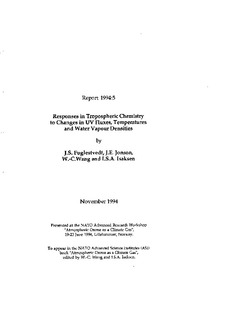| dc.contributor.author | Fuglestvedt, Jan S. | nb_NO |
| dc.contributor.author | Jonson, J. E. | nb_NO |
| dc.contributor.author | Wang, Wei-Chyung | nb_NO |
| dc.contributor.author | Isaksen, Ivar S. A. | nb_NO |
| dc.date.accessioned | 2014-03-17T14:29:36Z | |
| dc.date.available | 2014-03-17T14:29:36Z | |
| dc.date.issued | 1994 | nb_NO |
| dc.identifier.issn | 0804-4562 | nb_NO |
| dc.identifier.uri | http://hdl.handle.net/11250/191914 | |
| dc.description.abstract | A two-dimensional chemistry/transport model of the global troposphere is used to study the chemical response to i) increased UV-radiation from stratospheric ozone depletion and ii) increased temperatures and water vapour densities that follow from in-creased levels of greenhouse gases. Increased UV radiation increases the photolysis rates for several tropospheric gases, in particular ozone. This leads to enhanced levels of odd hydrogen and reduced concentrations of tropospheric ozone. Increases in temperature and water vapour densities reduce the levels of tropospheric ozone through temperature dependent reaction rates and increased production of odd hydrogen. In both cases the methane levels are also reduced. Thus, the results indicate that the considered mechanisms constitute damping effects on global warming. For a global temperature increase of 3.88 K, the levels of tropospheric ozone and methane are reduced by about 10% and 18%, respectively. | nb_NO |
| dc.language.iso | eng | nb_NO |
| dc.publisher | CICERO Center for International Climate and Environmental Research - Oslo | nb_NO |
| dc.relation.ispartof | CICERO Report | nb_NO |
| dc.relation.ispartofseries | CICERO Report;1994:05 | nb_NO |
| dc.title | Responses in tropospheric chemistry to changes in UV fluxes, temperatures and water vapour densities | nb_NO |
| dc.type | Research report | nb_NO |
| dc.source.pagenumber | | nb_NO |
